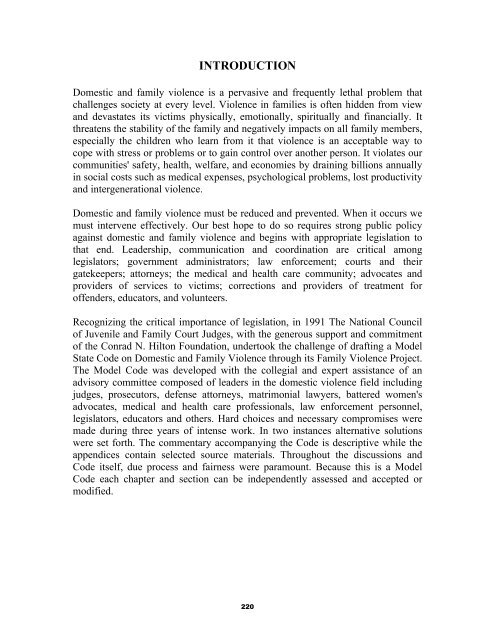A Judge’s Guide
A Judge’s Guide
A Judge’s Guide
You also want an ePaper? Increase the reach of your titles
YUMPU automatically turns print PDFs into web optimized ePapers that Google loves.
INTRODUCTION<br />
Domestic and family violence is a pervasive and frequently lethal problem that<br />
challenges society at every level. Violence in families is often hidden from view<br />
and devastates its victims physically, emotionally, spiritually and financially. It<br />
threatens the stability of the family and negatively impacts on all family members,<br />
especially the children who learn from it that violence is an acceptable way to<br />
cope with stress or problems or to gain control over another person. It violates our<br />
communities' safety, health, welfare, and economies by draining billions annually<br />
in social costs such as medical expenses, psychological problems, lost productivity<br />
and intergenerational violence.<br />
Domestic and family violence must be reduced and prevented. When it occurs we<br />
must intervene effectively. Our best hope to do so requires strong public policy<br />
against domestic and family violence and begins with appropriate legislation to<br />
that end. Leadership, communication and coordination are critical among<br />
legislators; government administrators; law enforcement; courts and their<br />
gatekeepers; attorneys; the medical and health care community; advocates and<br />
providers of services to victims; corrections and providers of treatment for<br />
offenders, educators, and volunteers.<br />
Recognizing the critical importance of legislation, in 1991 The National Council<br />
of Juvenile and Family Court Judges, with the generous support and commitment<br />
of the Conrad N. Hilton Foundation, undertook the challenge of drafting a Model<br />
State Code on Domestic and Family Violence through its Family Violence Project.<br />
The Model Code was developed with the collegial and expert assistance of an<br />
advisory committee composed of leaders in the domestic violence field including<br />
judges, prosecutors, defense attorneys, matrimonial lawyers, battered women's<br />
advocates, medical and health care professionals, law enforcement personnel,<br />
legislators, educators and others. Hard choices and necessary compromises were<br />
made during three years of intense work. In two instances alternative solutions<br />
were set forth. The commentary accompanying the Code is descriptive while the<br />
appendices contain selected source materials. Throughout the discussions and<br />
Code itself, due process and fairness were paramount. Because this is a Model<br />
Code each chapter and section can be independently assessed and accepted or<br />
modified.<br />
220


